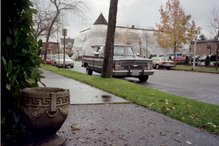The New Park Footbridge Project Seems to Connect to A Previous Pedestrian Path From Point Defiance Park to Ruston Way
Other moments return to my mind at Point Defiance Park and at Ruston. Among these: my father briefly worked at the smelter, and a member of my mother's First Lutheran Church confirmation class in 1927 ?, a Stanley Nelson, not the only Stanley Nelson, wrote poems of his work at the slag heap of the smelter, he was championed by his daughter Mary Ann Nelson and by Historian Tom Stenger. My visits are seldom now, but an autumn or two ago as I walked toward the park entry an idea of Stanley Nelson's daughter became a spiritual guide: I imagined that she, who became a college professor of children's literature, got off the bus where I just had, in a darkening Saturday afternoon, a child with a load of books that included some favorites of mine, the Dean Marshall series.
The nearby park from her childhood might have connected her to the meanings of nature in childrens' favorites. And also returns to my mind a visit at Tom Stenger's house with her for snacks after the Memorial service for Stanley Nelson at the church after Stanley Nelson' s death. Ruston had been home, I thought on June 3, 2017, and looked up a steep newer street. I left the new Number 15 Pierce Transit Line where above a Northwest Corridor passenger train vanished into the tunnel entry, at Yacht Club Road.
Among my mother's mementos is a 1930s photo on a newspaper magazine supplement front cover where she indicates where her father's fishing boat was moored, just off the edge. One brother would drive her younger brother out to bring the fishing boat to the Old Town Dock, where everyone could get on so they could cross the bay to visit my grandmother's brothers-in-law, Birger and Eric, on Rosehilla Beach. My mother's father died in 1931.
There is to be a pedestrian bridge from the park to Ruston Way. I found one side of the bridge not far from the statue of the man who protected the peninsula of trees and established it as a city park. I thought I could figure out where the other side of the bridge might be. So walked down Yacht Club Road and took some pictures.
The park has been separated from Ruston Way by the Smelter. I found some three-year-old pictures from an October 2013 Walk and Bike along the waterfront in which I took my bicycle on the bus to the entrance to a hillside path just beyond the portables of the Science and Math Institute of Tacoma Public Schools. Then a path traversed along the hillside to land at the wide generous horizons of a spacious Waterfront. Now the project removes a lot – path fences, trees, and portables and more.
In my photo a pointy place recently advanced in the new bridge project can be viewed from both sides, Point Defiance, and Ruston Way. Yes, the bridge seems to connect what had been the traversing pathway to the park.
A photo from 2013, October, shows a fence: stories of my father say the fence style is a often-used fence style of the early settlers in Whatcom County, where he was born on the shores of Lake Whatcom. (His family came there and bought a home from people retiring to town in Bellingham. That was how my father happened to be born in a log cabin in 1902.)



